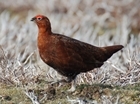GWCT News Blog
-

in:
GWCT News Blog
In the previous piece, I explored how ant colonies resemble multicellular bodies. Here, I turn to my DPhil research, which investigated these ideas through comparative studies of social evolution.
-

in:
GWCT News Blog
Solar is often presented as a southern England success story, where higher levels of irradiance make large-scale generation straightforward. But with technology evolving rapidly, land from Carmarthenshire to Caithness is proving suitable for solar development.
-

in:
GWCT News Blog
under:
GWCT Scotland
, Advice
NatureScot has issued new General Licences for 2026, which are in effect from 1 January to 31 December 2026. Wildlife managers operating under General Licences are required to understand the current licences and comply with their terms and conditions.
-

in:
GWCT News Blog
under:
Policy
, Nature
This week, in line with its manifesto promise, the government has announced its new Animal Welfare Strategy, setting out plans for ‘generational reforms’ to animal welfare it hopes will help protect wild, farmed, and companion animals across the UK.
Our experts will be studying the detail of this new strategy and providing a full response in due course. In the meantime, we wanted to provide some initial thoughts on the implications for introducing a close season for hares and limiting use of snare devices.
-

in:
GWCT News Blog
I like to think of myself as an ant colony. Each cell is ant, and many different cells (ants) work together to form the complex higher entity that is Me (the ant colony). This might sound a bit insane, but it has a real scientific basis, and one that I explored in depth during my DPhil.
-

in:
GWCT News Blog
Where do birds live? Many still imagine robins in hedgerows or owls in hollow trunks. But waders, gamebirds, warblers, buntings, pipits, chats, larks, wagtails, nightjars, waterfowl, gulls, terns, even raptors like short‑eared owls - all of them are ground nesters.
-

in:
GWCT News Blog
When I started my degree in Environmental Science at the University of Sheffield, I knew I wanted to do a placement year, it was just a question of what. I chose Sheffield because of its proximity to the Peak District’s open landscapes, and throughout my first year I developed a keen interest in wildlife and conservation through several modules.
-

in:
GWCT News Blog
under:
Big Farmland Bird Count
, Farming
, Advice
As winter seems to be in full swing, many organisations are encouraging us to feed the birds. They are reminding everyone to maintain consistency, while also advising on what and how to feed for the best results. This is largely targeted towards garden birds, which can be significant when our gardens make up 4.6% of the land use in the UK. However, farmland makes up a huge 72% of the land use in the UK.
-

in:
GWCT News Blog
10 December marks the official end of the grouse-shooting season in the UK. Thus, it provides an excellent opportunity to update on the results of the health testing in red grouse carried out by the GWCT Advisory Services in Scotland in 2025.
-

in:
GWCT News Blog
Fingask Castle on Sunday 7th December was the setting for a great day of celebration for a select group of youngsters as they were awarded for their artistic talent.
Get the Latest News & Advice
Join over 100,000 subscribers and stay updated on our latest advice, research, news and offers.
*You may change your mind any time. For more information, see our Privacy Policy.